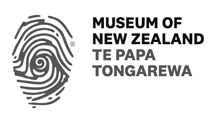Wimoka Smith

“Our Most Treasured Memories”
Wimoka as my eldest child of seven children. He grew up on a farm north of Auckland under the love and guidance of his grandmother, whom he loved dearly.
His love of the arts was obvious as a child but came to full bloom in his adult years. Wimoka has a beautiful voice and used it often to express his love of people. To hear him sing was magic! His expressions towards the end were music, “Unchained Melody”, “When a Boy Falls in Love”.
Wimoka qualified as a machinist with guidance from an aunt. He also designed men’s, women’s and children’s gear, as well as exclusive designs for family and friends for which he won awards. Wimoka’s other interests were leather, bone and wood carving, logos, and dot and freehand drawing.
Wimoka loved his whanau and never forgot special occasions, especially at Christmas and for birthdays. He always sent cards.
Though his life was shortened by AIDS he lived a very full life. He shared his hurts and regrets with me and our whanau and for that, we will always be eternally grateful.
May Wimoka’s memory help other whanau at their time of great need. May God’s love and guidance give them strength.
We, the whanau of Wimoka, give the NZ Quilt Project permission to use our memories of Wimoka as a token of our love to other whanau.
With loving thoughts to all,
Alma Smith (Wimoka’s mother)
From the book “Unfolding: The Story of the Australian and New Zealand AIDS Quilt Projects“
I’ve been nursing all my life. I have six other children besides Wimoka. Three girls and three other boys. I suppose I enjoy life and try not to worry too much about what’s been, and hopefully what’s to come will make a lot more sense.
Wimoka had many talents. He qualified in dressmaking and was a beautiful artist. He loved his brothers and sisters and he cared about life. As a son and a brother, he was loved very dearly. His grandmother thought the world of him, and he carried the name of my father, who I never knew. My husband was his step-dad and you would never have known that he wasn’t his real dad. He had great respect for him. My youngest daughter was only eleven when he died.
My mum and sisters and I found out about the Quilt through a coordinator in the Kaitaia region. We sat down one afternoon and decided how we were going to make this quilt. Myself and my mum and Huia my older sister. Wimoka’s quilt is made up of a whole lot of love and the depth and the intensity of the quilt is from our hearts.
The white rose signifies the love that his cousins all had for him. It’s from his oldest cousin in the girls, Lee. The chain is the trail of love that comes from the rest of the cousins, and the word ‘love’ was from all of them, his brothers and sisters, his cousins.
Wimoka’s grandmother was an ardent crocheter and he always loved her work. Those little hats are just ‘I love you’ from Nana. He’s also got what you call the baskets of knowledge. The baskets of Knowledge being the knowledge that he imparted during his lifetime. The knowledge of heart and hope and life and death. He has, on his panel, a lifetime membership of the Maori Women’s Welfare League. My mother is one of the few remaining life members of that association. She was one of the founding members in 1943 of the Taitokerau District. She was presented that badge in 1953 and, in her love for Wimoka, she imparted it to his panel.
Another brooch on his panel is from the Catholic Mercy Hospital and this comes from me. The other basket of knowledge belongs to his grandmother. They signify life in the true sense. From a Maori point of view, the basket of knowledge is my mother being able to impart a whole lot of things that made up my life, that made up Wimoka’s life. They contain the understanding to, hopefully, educate people.
The red velvet material the panel is made up of, Mum bought many years ago. It was a piece that Wimoka always wanted. She felt it was an appropriate remembrance for him. The guipure lace that surrounds the panel was used years ago on bridal gowns and was also a piece that Wimoka admired. I did the date that he passed away . . . sat down all afternoon trying to make it as nice as possible. He was always a very conscientious person in that respect. “If you don’t do it properly, it wasn’t worth doing.” I think we probably all inherited that.
Even as I am sitting here nearly three years down the line it’s as if it was just yesterday that all this took place.
The past ten years, prior to Wimoka’s death, I’ve been involved in the care of terminally ill patients at the St. Joseph’s unit at the Mercy Hospital. Wimoka actually passed away in the unit and all the people that looked after him were all very dear friends of mine. So it became like my own extended family.
The Taitokerau block that Wimoka is on is made up of many people that I have got to know. Wimoka’s great-great-grandfather actually sold the land to Ian’s (the panel next to Wimoka) grandparents, when they first settled in the northern district. Wimoka’s panel is the Maori side of the Kaitaia district and Ian’s is the Pakeha side. I still miss Wimoka very, very much today. We shared many, many lovely thoughts and there was a song that he always sang to me that was called ‘When a Boy Falls In Love‘. Wimoka had a beautiful voice. He could sing any song. His grandmother often says today that he wasn’t meant for this world.
I remember him saying to me once, ‘My greatest wish would be to give you a grandchild. Which I can’t do.’ I said to him that even if he couldn’t give me what obviously hurt his heart so very deeply, I was happy that he was such a loving son.
The day that Wimoka and I actually got the confirmation that he was dying of AIDS and that it could only be a matter of weeks, he looked at me and said, ‘Mum, I don’t want to die. Why was I so stupid?’ I said, ‘No, it wasn’t stupidity that brought you down this road, it was lack of education.’
Wimoka left behind some nieces and nephews, and I know that, in his heart, if they have a safer world to live in, then his death would never have been in vain.
When the panel was made up in Whangarei, Nicki Eddy [National Convenor of The Quilt Project at the time] was designated to take it to the South Island, to the Dunedin unfolding. Three of us decided that we would like to go too. We left Auckland early one morning and travelled all night to Dunedin. There was a big snowstorm down in the South Island at that time and planes couldn’t take off and people couldn’t use the roads. We caught the ferry in Wellington and went across. The snow was blocking the roads behind us. Prior to getting to Dunedin, they had closed the road and we had to detour. It was as if everything had waited for us. By all calculations, we should not have even made it to the South Island.
But we got to Dunedin and were privileged to be there and hand it over to the people of Dunedin with the full blessing of the Mayor of Dunedin and many other respected citizens of the community. It was a real thrill to say that our Taitokerau block had been right from the North, at Cape Reinga, all the way to the south where it was handed over with the dignity with which it left our area.
To me, the Quilt Project is a very important part of our whole grieving. I still feel a deep sense of loss for Wimoka, but I know that what his panel is doing is educating. So, hopefully, my loss is someone else’s gain. The Project and what it represents has helped me to heal. I know that Wimoka’s panel is only a small token of what he really was in life, but if it helps anybody in bringing their awareness to the fore, then it will be a blessing.
You look at the Quilt and could think, ‘Oh, they’re just pieces of material put together’, but to the Maori you are actually taking a spiritual person and as such it doesn’t only depict Wimoka, it depicts my father and cousins of his and mine and you are actually taking the history of the whole family.
This is Maori aroha, the love that we felt for the ones that are on his quilt.
Alma’s mother, Maude Smith, who assisted her in the making of Wimoka’s panel, passed away on 15 January 1994. She is resting between Wimoka her husband, and Wimoka her beloved grandson.
Wimoka’s mother has also provided us with this undated photo of Wimoka.
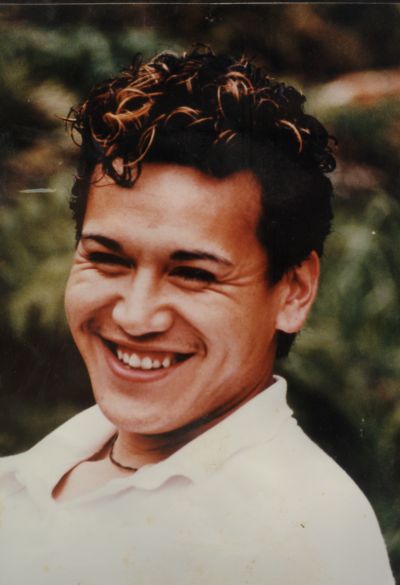
Add a memory to this panel
If you wish to add your memories to this page, please get in touch.
Ian Francis Neville Matthews

Ian was the oldest of his generation and had a very special relationship with his grandparents. In fact, most of his school holidays were spent at their Ahipara home. After receiving his early education at Kaitaia Primary School Ian went to Kaitaia College where he became Head Boy in 1965. During his college years, and with the support of his mother (who was a founding member of the Kaitaia Dramatic Society), Ian took an active role in stage productions. His major success and still well remembered was his virile handling of the lead in a college production of Hamlet – a role he played a second time at Training College.
After Training College and university studies, Ian returned to Kaitaia to teach sciences at the College in the 70’s. He then taught at several Auckland schools before leaving on the first of two trips to London.
Ian returned from his second trip in November 1985 and taught in Auckland until his illness forced him into early retirement in May 1987. Ian elected to come home to Kaitaia for what proved to be his last 10 months of life. While he was well enough, Ian stayed at his Pukepoto home which is depicted on his Quilt. He bought the land in the early 70’s then purchased the Trimmell Cottage at Mangonui, which was transported over. The restoration and extension of his house was to become an on-going project for 5 years. Ian demolished the original Kaitaia school building in 1974 and the kauri timber from this is incorporated in his home.
Matching his interest in old houses was his research into family history both in New Zealand and overseas. The initials on the Quilt are those of Ian’s ancestors as far back as presently known. Members of the family are aware and grateful that it was Ian who saved many valuable family documents in the form of diaries spanning 1860 – 1941 and many historical photographs.
Ian’s other love was motorbikes. His first was a Jawa, then 2 Triumphs, a reluctant succession of Japanese Hondas and Suzukis, culminating in a Kawasaki 750 LTD. But he really loved the British bikes, hence the “Triumph” on his Quilt. Ian was a keen member of various motorcycle clubs both in NZ and the UK. He had a phenomenal collection of leather gear suitable for all conditions.
It was not until 11 months before he died that Ian allowed his condition to be made known to his family, yet he had known for almost 3 years. This illustrates the almost Jekyll and Hyde existence which we knew Ian lived. He wanted to protect his family yet he also wanted to shout to the world who he was and that he was unashamedly gay.
Ian made the decision to return to Kaitaia knowing that he had our full support, and after a few hiccups, we, in turn, had the support of our friends and community. In fact, Ian and his condition became a real educator.
His forefather was the first permanent European settler in the Kaitaia District, the first of many. Ian was the first person with AIDS, and in his words, “I certainly won’t be the last!”. How right he was.
Ian died on March 9, 1988. Rest in Peace, “Bruv”.
With love,
Warren and Margaret Matthews (Ian’s brother and sister-in-law)
Ian’s has also provided us with this undated photo of Ian which has started to fade.
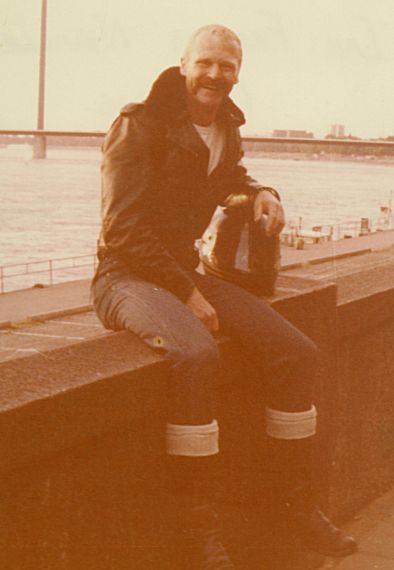
Add a memory to this panel
If you wish to add your memories to this page, please get in touch.
Joe Wellington
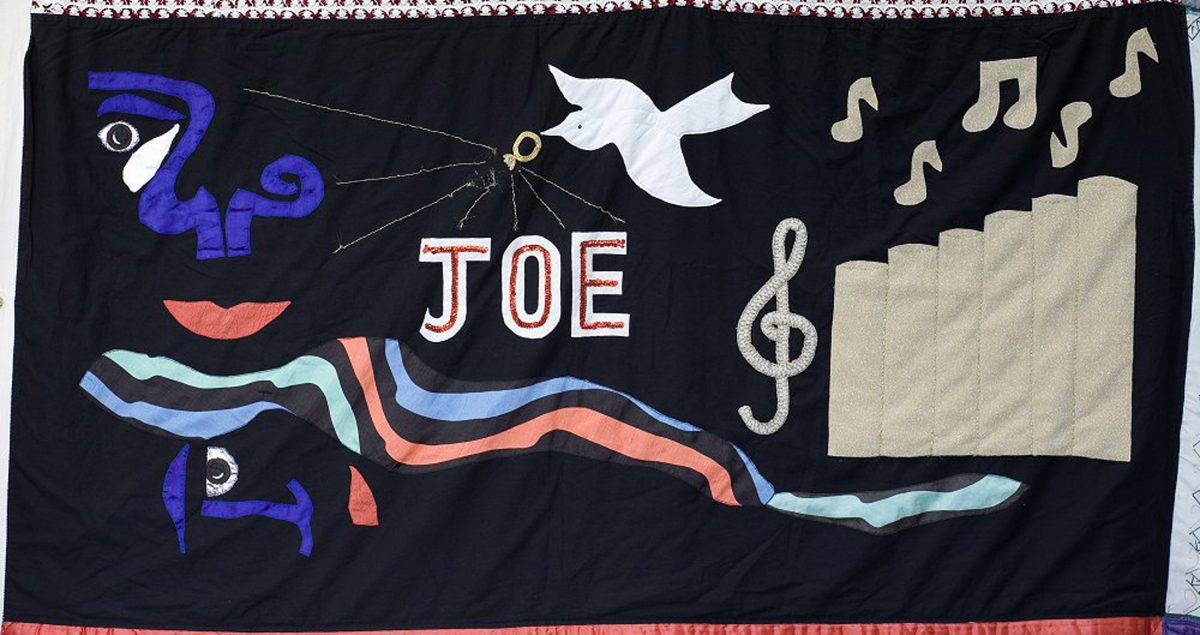
This Quilt was designed and stitched by members of Joe’s family, and friends.
The contents of his Quilt all have a particular meaning:
| Black background | significant of his black cape |
| Diamond dress ring | Joe’s favourite |
| Dove | sign of peace, understanding and love |
| Organ pipes | Joe’s musical talents |
| Faces | one depicting his earlier life, and one depicting his life in the hereafter |
| The Waves | depicting the passing from his earthly life to his spiritual life |
Peter remembers Joe:
Add a memory to this panel
If you wish to add your memories to this page, please get in touch.
Walter Edward
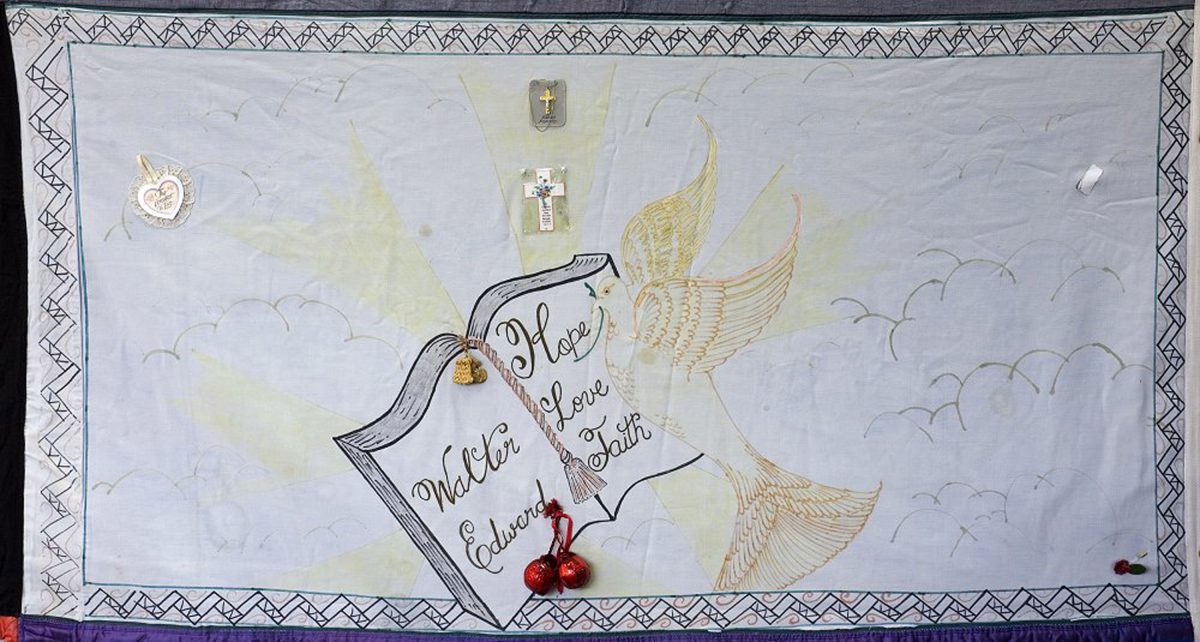
Sadly, at the time of setting up this website, we have no information about this panel.
Add a memory to this panel
If you wish to add your memories to this page, please get in touch.
R.J.

The below was shared with Te Papa and this site by Raymond Ututaonga, R.J.’s relative:
R.J. stands for Reginald Joseph: his full name is Reginald Joseph Ututaonga.
The horse represents his love for all the horses he had especially Boy, who was a favourite.
The bus and bach represent where he loved to go and is in a small rural area called Waiomio. I also stayed there as well every so often (still stands there today up on the hill next to State Highway 1).
The hills behind the bus are supposed to be the hills looking straight out from the bus on the other side of SH1 (Range Road).
The hibiscus plant, I think it is, but that flower represents his love for Tahiti as he spent time there.
The Māori designs and Pacific designs represent his love for his culture and the Tahitian culture.
The rainbow…there’re quite a few meanings.
The dates of when he was born and when he passed (22 October 1951 – 1 May 1991).
This panel was drawn by our family members, who at that time were probably in their teens and primary school.
Add a memory to this panel
If you wish to add your memories to this page, please get in touch.
Spring
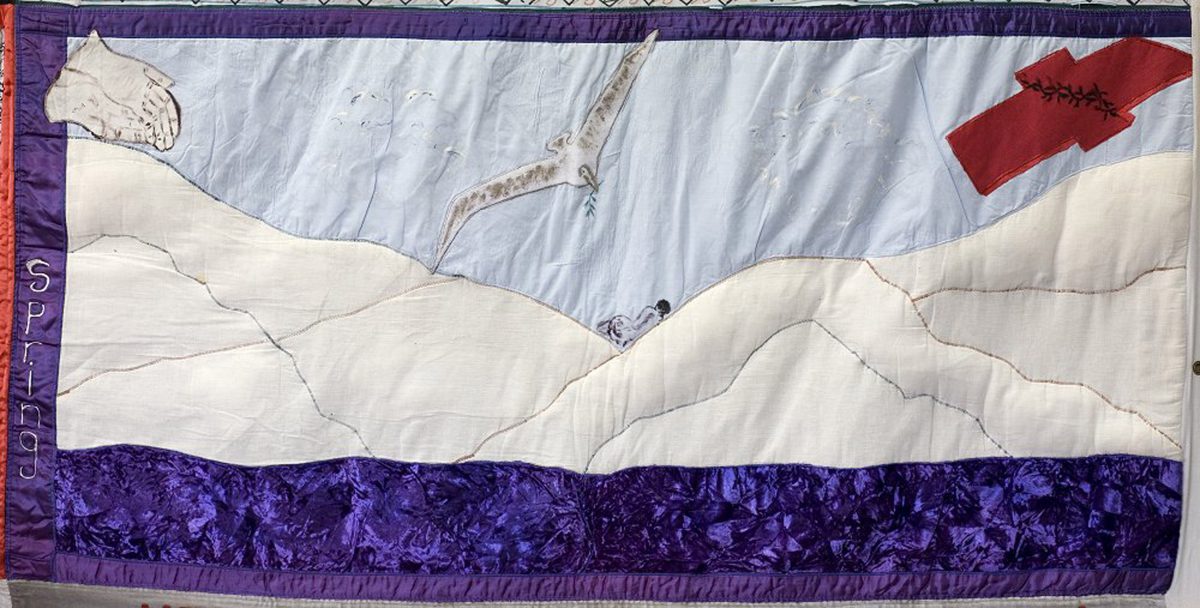
Taken from the book “Unfolding: The Story of the Australiana and New Zealand AIDS Quilt Projects“
Spring’s Quilt by Bessie Hohepa
My husband’s name was Spring. We were almost twenty when we got married. When I look at it now, I think we were too young. Consequently, we went through a lot of hard times. In 1989 we got a divorce. We had been living apart for about five or six years. Two and a half years ago, Spring died from an AIDS-related illness.
We told the children that he had AIDS and that he was dying; there was never any question that we were not going to tell them. Their reaction was, ‘Dad, we love you.’ They all jumped on his bed and we were all crying. We had about a month with him before we had to come back home to Whangarei, and in that month we talked more than we ever had.
One day in the hospital, Spring said to me, ‘Would you marry me again?’ I said, ‘Yes, give me a week to sew up a new dress.’ As it goes, he died on the second weekend in March, so we never got a chance to get married but I guess the important thing is that he asked me and, more importantly, we knew that we loved each other anyway. That memory is something that I will hold precious always. When life has a short span then you really get down to the nitty-gritty. I thank God that I had that opportunity to do that with him.
Spring loved the land and the sea. He was a very vibrant, very motivating person to be around. When he did something, he did it with his whole heart. He was a good husband and a good father. So we wanted to depict that on our quilt. We picked a royal blue, a calico material for the land and a lighter blue for the sky. We have put the sea on the quilt at the bottom. He loved going fishing and camping. Those are the sorts of things that the children really enjoyed doing with him.
We’ve done the land in an earthy-toned calico and zigzagged the hills in different colours depicting different shades of the earth. When he was back with his mother on the farm, he had big gardens going with corn and kumara and potato. Our children used to help him in the garden, weeding. The gardens around the house were always really tidy with flowers and lovely colour everywhere, the lawns always manicured. He loved the country more than the city, the quietness and the tranquillity of it.
The white designs on the sky represent the stars and I puff-painted clouds on. In one corner on the left-hand side, we put a pair of hands. To us, that represented God, and how when Spring had made his peace with God, we had a strength to go on because we knew that he would be going into the Father’s arms. The dove represents the Holy Spirit.
From the red cross, down to the little figure in the middle of the hills, which represents Spring at rest within the earth, and up to the dove, is a fine line of glitter, which represents the peace that he received through Jesus Christ. Inside on if the hills is a bell, so that every time that the quilt is lifted up and billowed when they have a showing, the little bell will tingle.
There are about eight or nine quilts from the Taitokerau region. We joined them at the Marae at Titoki. It was really nice to sit around with the other families, sewing things together by hand, putting last-minute touches on, singing away with each other, retelling stories. I found being able to talk to people, really knowing that they understood where I was coming from and where I’d been, was very healing for me.
I have a special feeling for our Taitokerau quilt. I know that it has aided a lot in education in this region. It’s really neat to know that our quilt will have that effect on other people. To be able to use it to educate people is a great thing.
When people found out, in his little community, that Spring was diagnosed HIV-positive, they ostracised him. He was a very important part of that community. He was responsible for instigating a lot of their work schemes, was very involved with the children’s rugby, the Marae. He was their chief fundraiser, their chief cook.
To have the community turn on him like that hurt him really badly. I’ve never known Spring to run away from a situation, but he ended up having to because he was feeling so sick. The ostracism on top of that was too much.
The hardest thing to deal with has been people’s ignorance. Shannon too was ostracised by his teachers and his peers when they found out what was wrong with his dad. He got to such a state where he was really explosive and had to leave school, and when I went for counselling from a pastor at the church, I was told not to tell anyone else in the congregation. I found that really hard to cope with because I really needed to talk to people.
However, I have dealt with that and I have been able to carry on. My life is rich and it’s full, it’s hard sometimes, but I have a strength now that I never had before. I am more able to plot my course. I know I am going to be a good nurse. I will know what people are going through.
I found a release, really, in doing the quilt. Before that, the children and I just dealt with it on our own. No one on the outside knew. Doing the quilt has helped us to, you could say, go public. It has helped us in another stage of accepting what has happened in our lives.
Spring told me once not to fret and I’m not. I’m looking forward to the rest of my life. I’m looking forward to the things that are going to happen, to the grandchildren we’re going to have, and it’s really sad that he’s not here to share it, but I know that in spirit he’d be with us.
At the time of writing this, in the mid-1990’s, Bessie was studying to be a registered nurse in Whangarei where she lived with her three boys aged between 12 and 20 and a 6-year-old daughter with cerebral palsy. All the children helped Bessie in the making of Spring’s Panel.
Add a memory to this panel
If you wish to add your memories to this page, please get in touch.
Gavin James Timperley

He was the fourth and youngest child in our family. Over the years he gained many true friends from many walks of life, young and old.
Gavin loved music and spent many hours at the piano, at roller skating and ballet. He was also fond of flowers and gardening and was a very able cook.
He grew to be a caring, gentle man who loved life, and worked hard and successfully with enjoyment, at his chosen profession in the administrative side of the insurance industry.
As a family, Gavin taught us what courage is about and what love means. We remember his patience with and wonderful kindness to, Gaye, his intellectually handicapped sister, who adored him. I remember his charity to one whose words had hurt him.
Despite his illness, Gavin kept his sense of humour, with always a smile for everyone.
As his mother, I shall always remember his love and friendship and count as precious the time we had together.
Memories are always with us, happy times, funny things, sad things – they are to be treasured.
Gavin left us, released from pain and at peace, with a legacy of love and friendships which we value.
Finally, thank you to those responsible for the New Zealand Quilt Project. We thank you for the opportunity to celebrate Gavin’s life in this way. May the Quilt help in giving understanding to New Zealanders, and also love and hope to all people living with AIDS, their families, partners and friends.
Phyllis
Gavin’s mother has also provided us with this photo of Gavin taken in October 1988.
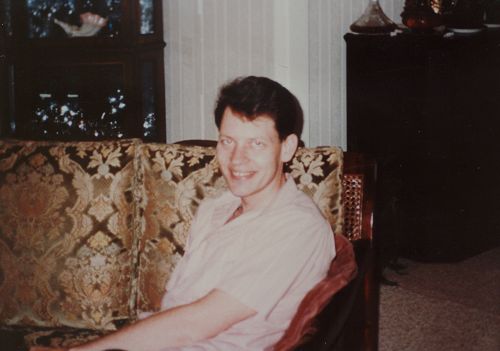
Add a memory to this panel
If you wish to add your memories to this page, please get in touch.
Neville John Thomson
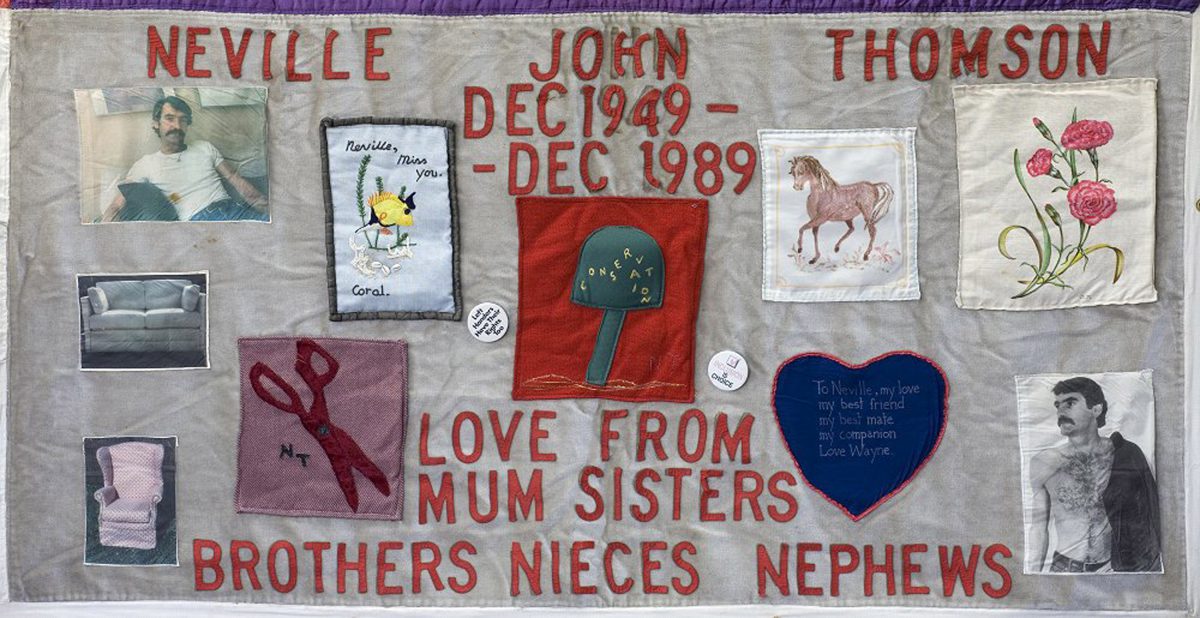
Neville was born at Te Kopuru Hospital (Dargaville area), the third of ten children, and was brought up in Auckland. He was apprenticed to an upholsterer when he left school.
At the age of nineteen, he travelled overseas and lived and worked in England and Scotland for the following eight years. When he came home to New Zealand he set up his own upholstery business. He eventually left Auckland to live and work in Wellington, where he remained until he died.
Neville enjoyed the good life and lived it to the full. He cared deeply for his fellow human beings and was devoted to his partner, Wayne, and to his mother, and brothers and sisters.
SIGNIFICANCE OF THE PANEL DESIGN.
Created by his mother, sister and partner the panel shows:
Special photos of Neville.
The heart with the verse was special from Wayne.
The horse suggests Neville’s interest in having a flutter on the horses.
The seahorse shell design worked by his sister to signify Neville’s love of swimming and the beach.
The scissors and furniture represent his work.
The carnations design was painted by his mother because of their perfume and because they were special to Neville.
The stylised tree represents his interest in conservation and also his love of conversation and arguments over issues.
Add a memory to this panel
If you wish to add your memories to this page, please get in touch.
About this block
This block is also known as the “Taitokerau Block” as it is made up of panels made for people from the Taitokerau region in Northland.
Before assembly, each panel was taken to North Cape where they were fluttered in the breeze to release the spirits of those whose memory they celebrate before being taken to the Titoki Marae where they were joined to form this block.
Other photos of this block
Panels in this Block
| Panel Name | Life Years | Panel Link |
|---|---|---|
| Gavin James Timperley | 8 April 1956 - 12 March 1989 | View Panel › |
| Ian Francis Neville Matthews | 25 September 1947 - 9 March 1988 | View Panel › |
| Joe Wellington | View Panel › | |
| Neville John Thomson | December 1949 - December 1989 | View Panel › |
| R.J. | 22 October 1951 - 1 May 1991 | View Panel › |
| Spring | View Panel › | |
| Walter Edward | View Panel › | |
| Wimoka Smith | 20 December 1961 - 28 February 1991 | View Panel › |



